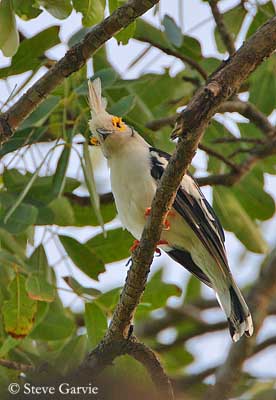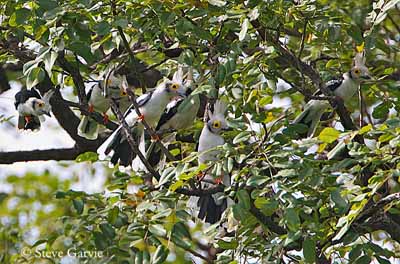
White Helmetshrike
Prionops plumatus
Passeriforme Order – Prionopidae Family
BIOMETRICS :
Length: 19-25 cm
Weight: 25-49 g
DESCRIPTION:
White Helmetshrike is a striking bird often seen in groups among the foliage of the trees.
Fr: Bagadais casqué
All : Brillenwürger
Esp : Alcaudón de Copete Yelcobé
Ital: Averla dall'elmo crestalunga
Nd: Helmklauwier
Russe: Длиннохохлый очковый сорокопут
Photographers:
Didier Buysse
Vision d’Oiseaux
Steve Garvie
RAINBIRDER Photo galleries
Text by Nicole Bouglouan
Sources:
HANDBOOK OF THE BIRDS OF THE WORLD Vol 14 by Josep del Hoyo-Andrew Elliot-David Christie - Lynx Edicions –
ISBN: 9788496553507
BIRDS OF AFRICA SOUTH OF THE SAHARA by Ian Sinclair and Peter Ryan - Princeton University Press Princeton and Oxford - ISBN: 0691118159
BIRDS OF THE GAMBIA AND SENEGAL by Clive Barlow and Tim Wacher – Helm Field guides – ISBN: 0713675497
CREAGUS@Monterey Bay (Don Roberson)

Adult has black mantle, wings and tail. The upperwing shows a broad, long, white wing bar. The black tail has black central rectrices and white outer feathers and tip.
Underparts are pure white. The white wing bar is very conspicuous in flight seen from below. The wings are broad and rounded.
On the head, forehead and crown are pure white. Adult has an untidy white crest, often curling forwards. The crest is about 45 mm long in the nominate race. A black bar forms a narrow crescent behind the eye. The nape is tinged grey but the neck is pure white.
The bill is blackish. Eyes are dark grey surrounded by conspicuous orange-yellow eye-ring with scalloped fringe, similar to a yellow flower. Legs and feet are pinkish-orange to red.
Both sexes are similar.
Juvenile is browner. The upperpart feathers are tipped-buff. Eyes are brown and lack the eye-ring. It has short crest and lacks the narrow black crescent behind the eye. Legs and feet are yellower. It will need one year to reach the adult plumage.
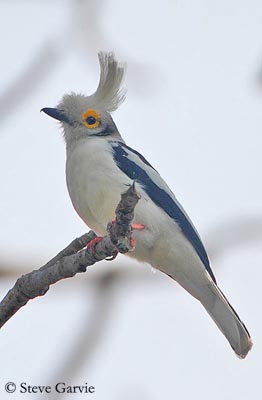
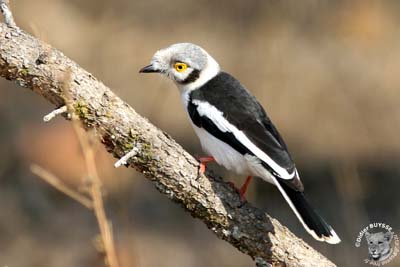
We find five subspecies which differ in size, and share the sub-Saharan range.
The two races displayed here are:
P.p. plumetus with grey eyes and long crest (left)
P.p. poliocephalus with yellow eyes, shorter crest and greyer head (right)
The other races “concinnatus”, “cristatus” and “vinaceigularis” have shorter crest and yellow eyes. The race “vinaceigularis” lacks the white wing bar.
VOICE: SOUNDS BY XENO-CANTO
White Helmetshrike is a noisy bird when in social groups. This species has wide repertoire of calls, including dry rattles, clicks, bill-snapping, growls (aggressive calls), buzzing, whistling and chattering notes (through the group).
Many calls are given in chorus or duets, including during territorial displays.
Both mates perform duets to maintain the pair-bonds, with male uttering “yuki-yuki” and female responding “kidoki-doki”.
Alarm call is a shrill “tzee-tzee”. Contact call in flight is a soft “whit-whit”, but lost birds give a loud “treeu”. The main call is “cherrow-cherrow”.
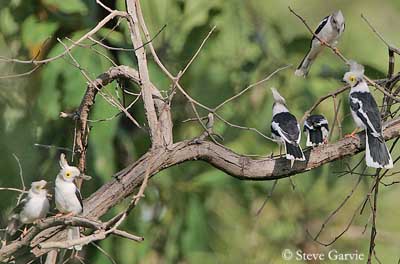
HABITAT:
White Helmetshrike breeds in tropical and subtropical dry broadleaf forest.
During the non-breeding period, these birds wander from acacia savannahs to other types of woodlands such as coastal forests and edges, wooded grasslands with scattered trees and oil-palm, eucalypt and pine plantations. They also may be seen in gardens and urban areas.
White Helmetshrike occurs up to 1800-2200 metres of elevation, but usually below 1500 metres.
RANGE:
White Helmetshrike is found in Africa south of the Sahara, from Senegal to Sudan and Ethiopia, south to Kenya, Angola and NE South Africa.
BEHAVIOUR:
White Helmetshrike feeds on small invertebrates, small reptiles and fruit.
This species hunts at all levels, but mainly from middle to low vegetation. It is often seen among leaves, branches, twigs, and on the ground in winter.
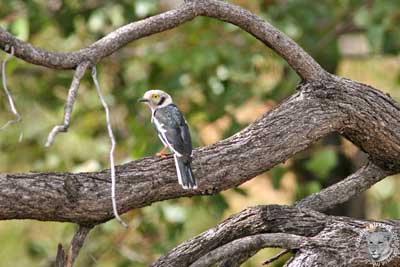
When hunting in trees, it may hang upside down, and hawk flying insects. This species lives and forages in groups of 2 to 20 birds in a home range sometimes shared with adjacent groups.
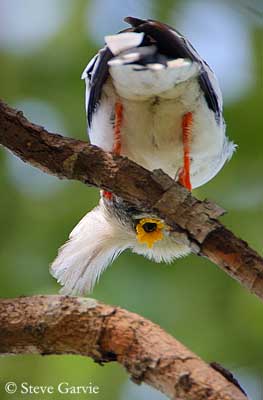
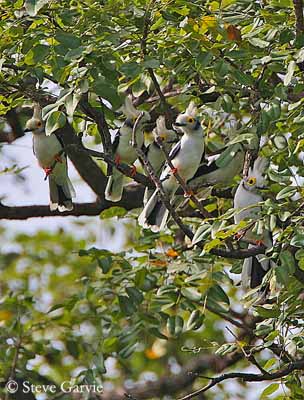
These groups are rather small during the breeding season, but they increase in post breeding season with the young birds.
The group progresses in series of short flight on broad front among the vegetation in woodlands. The birds which are at the end of the group regularly fly to front. They keep the same foraging path every day. Some individuals act as sentinels while the others are foraging.
They also may join mixed foraging groups.
White Helmetshrikes are largely resident within the range, but they perform seasonal movements including apparent and regular migrations in some populations.
The birds also perform altitudinal movements in non-breeding season. The southern populations are nomadic in dry season.
White Helmetshrikes are co-operative breeders. All the members of a group take part in nesting duties. There is a hierarchy between them, in descending order of dominance. Such breeding group may be stable for up to ten years.
The nests are at least 50 metres apart from each other, usually more. These birds are territorial during the breeding season, and the territory is defended by the group.
FLIGHT:
White Helmetshrike performs buoyant flight with much gliding. The flight action is fluttering and butterfly-like.
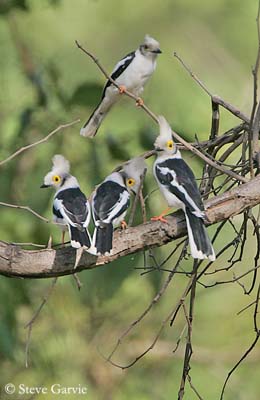
REPRODUCTION:
The breeding season varies according to the range.
Courtship displays by male involve wing-opening and slow wing-flapping. The male holds some nest material in the bill while approaching the female. Then, the breeding pair chooses the nest-site.
The nest is built mainly by the pair, but assisted by the helpers.
It is a compact cup made with bark strips, and heavily covered on the outer part with spider webs carried in the bill and on the frontal crest feathers.
The interior is lined with fine materials such as rootlets, grass and lichen. Thanks to the spider web, the nest is well camouflaged. It is placed between 2 and 10 metres above the ground, on the upper side of a branch, often at fork. The same nest-site is often reused year after year.
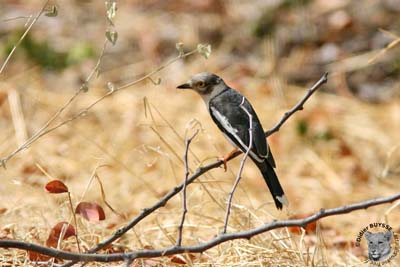
Female lays 2-5 eggs, and sometimes, two females lay their eggs in the same nest, giving a clutch of up to nine eggs. Incubation lasts about 16-21 days. The nesting period lasts 17 to 22 days during which the chicks are brooded and fed by all the members of the group.
The young birds are still fed for ten weeks more after fledging. They remain about five months and then, they disperse from the group, or remain as helpers.
The clutch is replaced if destroyed or lost.
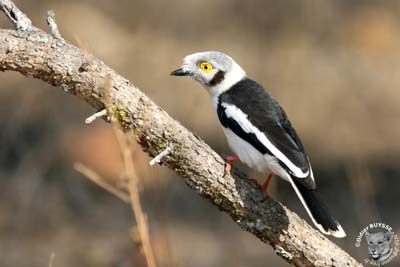
DIET:
White Helmetshrike feeds on caterpillars, butterflies, moths, grasshoppers, cicadas, flies and spiders. It also takes small reptiles such as geckos, and fruit.
PROTECTION/THREATS/STATUS:
White Helmetshrike is common in large parts of the range. It may be seen in numerous protected areas and national parks within the range.
This species is preyed upon by mammals, reptiles and birds of prey, but the populations are not globally threatened at this moment.
